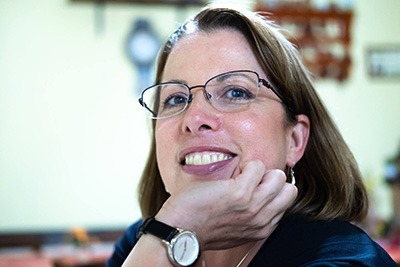 On this part of the Wooassist Interview Series, we talk to Lisa Shinham – owner of Wave Zone Skimboards. Together with her husband Jeff, Lisa first worked part-time building Wave Zone while she worked in corporate. At one point, the company experienced massive growth that Lisa had to leave her 15-year stint in the corporate world to focus on their company. “Good enough is never good enough” has always been their mantra. And now they own and a successful and thriving WooCommerce store that sells high-quality hand-crafted skimboards.
On this part of the Wooassist Interview Series, we talk to Lisa Shinham – owner of Wave Zone Skimboards. Together with her husband Jeff, Lisa first worked part-time building Wave Zone while she worked in corporate. At one point, the company experienced massive growth that Lisa had to leave her 15-year stint in the corporate world to focus on their company. “Good enough is never good enough” has always been their mantra. And now they own and a successful and thriving WooCommerce store that sells high-quality hand-crafted skimboards.
So let’s get started with the interview.
How did WaveZoneSkim start?
Wave Zone Surf Company opened in 1990 as a single location watersports store. Among the offerings were custom surfboards, skimboards, wind surfers and apparel. We expanded to include the wholesale of our skimboard brand to surf shops around the world. The growth was so massive that we decided to close the shop and transition purely to wholesale. As the customer need expanded, we found that we were able to reach additional market areas through our own website; a great option for holiday shoppers, those who do not live near a beach or surf shop location,
What are some of the major challenges for WaveZoneSkim?
Managing materials costs is a daily event, but one over which we can exercise some control.
Tougher to prepare for are the challenges presented by natural disasters. This year alone we have seen red tide spreading along the western coast of Florida, a hurricane strike to the eastern USA, a tsunami clipping Guam and volcanic activity threatening Hawaii. If one of our surf shops are affected, we are as well.
The exponential increase in online sales has created opportunity and challenge in equal measure. This could be counted as the largest ongoing shift in the way we do business today versus 25 years ago. Most significant is the detail needed for an individual transaction. This is much different and more labor intensive than shipping a case of a dozen boards to a surf shop. Customer expectations must be successfully managed on the front end. Fulfillment and customer service must be top notch.
What has been the biggest challenge in your career?
The largest challenge I have personally faced has been keeping up with technology. From e-commerce, to web design, to multiple social media platforms. Change is constant when determining how to best reach a customer. Having a good working knowledge as well as augmenting that by delegating to skilled individuals has been essential!
What are your tips on how to make a business startup a successful one?
Strategic planning is essential. It’s a relay race of sorts. A clear written timeline with each step assigned to a specialist. Communication is key. From concept to implementation to promotion to launch every step must be giving its due. Responsibility, accountability and respect to all must be flowing with the team working to build each other up. If the day has come to load website product then the individuals in charge of descriptions, SKUs, pricing and photography need to be aware and on point!

How has ecommerce changed over the past 10 years?
10 years ago there was a greater range of comfort in terms of buying online. As customers have gained understanding of secure sites and payment systems, closing the online deal has become far more achievable. Customers are largely at ease doing online business.
Today websites must be engaging and easy to navigate… truly streamlining the customer experience. A picture is worth a thousand words and the professionalism of your site must inspire confidence in your brand and products. A customer can comparison shop platforms and brands quickly and easily. The online marketplace continues to grow and a business must be on its game to stay out in front of competitors.
What do you think is the future of ecommerce?
The past few years ecommerce has paralleled brick and mortar business challenges. Smaller “mom & pop” retailers struggled to keep pace with big box stores, and still do. Today, online businesses battle the same fight to keep pace with large sites like Amazon. A marketplace the size of Amazon can afford to offer membership benefits such as free shipping and customer-centric return policies that can be tough for a small business retailer to match. With the continued increase in online sales, that pendulum is beginning to swing back a bit, with a bit more customer accountability to the tune of re-stocking fees and reduced eligibility for pre-paid return shipping.
With a continually growing base of tech savvy customers as well as online purchasing being the increasingly common choice, people will be continue to be more and more comfortable with doorstep delivery in many aspects of their lives. Convenience fees will become the norm and exceptional service will no longer include a huge ding to profit margins to secure the sale.
That said, however, individual sites will always need to continue bettering the customer experience in order to secure the business.

How did you get started with WooAssist?
A colleague mentioned WooAssist to me in passing. Upon visiting the Wooassist site, I found a video on the home page told my story well. Like many, I had invested a generous sum to rebuild my site. After completion of the project, I found myself buried under lack of knowledge regarding WordPress and its many plugins. I felt a bit stranded… as if I was in a newly built house with a bit of furniture yet so much more was still needed to truly live there and call it mine. I learned as much as possible via trial, error and online resources to add content and enhance the sites direction.
I had big ideas and no way to bring them to fruition. I bought a small support package from Wooassist and tested a small job. The recommendations and results have been amazing. The Wooassist staff has been responsive and proactive. Their service and follow through have been superior.
What advice can you offer for aspiring ecommerce entrepreneurs?
Continuing education in the areas of technology and online marketing is important. Learn about meta tags, keywords, H1 headings, etc. Outsourcing is highly effective but, like all other business investments, it’s important to know what you are paying for. A good blend of both paid and organic exposure is important. Top notch photography, engaging content and relatable videos are very achievable and worth the investment. Most importantly, automation is critical. With systems and automation that cover everything from FAQs to inventory control, people can use time where it needs to be spent, such as building business and relationships.









Leave a Reply